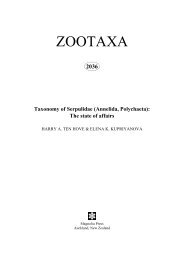You also want an ePaper? Increase the reach of your titles
YUMPU automatically turns print PDFs into web optimized ePapers that Google loves.
specimen (Cook 53) from the same locality has normal pinnae and staminodes. Both Desmoncus quasillarius<br />
and D. uaxactunensis were said to have peduncular bracts ‘entirely or nearly unarmed’ or ‘almost unarmed’,<br />
but both are spiny as in other specimens.<br />
Subspecific variation:—There is no geographic disjunction except for an outlying specimen from<br />
Nicaragua, but this is likely to be an artifact of insufficient collecting. Two specimens from Honduras (Evans<br />
1702, Saunders 553) have somewhat tomentose rachillae, more like those of Desmoncus moorei. Other<br />
specimens from Honduras have less pronounced beards of spines at the pinnae bases, although this may be<br />
because they represent young leaves.<br />
2. Desmoncus cirrhifer Gentry & Zardini in Gentry (1988: 1436), as “cirrhifera”.<br />
Type:—COLOMBIA. Valle: Bahía Malaga, 0 m, 4°02'N, 76°15'W, 16 December 1985, A. Gentry, M. Monsalve, C.<br />
Restrepo & J. Gamboa 53392 (holotype CUVC n.v., isotypes MO!, COL n.v., K!).<br />
Plants 11.0(3.0–20.0) m tall; stems 2.0(1.2–3.0) cm diameter, clustered. Leaf petioles 10.8(7.0–16.5) cm<br />
long; rachises 105.3(91.0–117.0) cm long, 6.0(4.0–8.1) mm wide, the spines usually 1 cm long, mostly adaxial or<br />
lateral, straight with briefly swollen bases; pinnae 9(8–10) per side of rachis, without long, filiform apices,<br />
A REVISION OF DESMONCUS (ARECACEAE)<br />
Phytotaxa 35 © 2011 <strong>Magnolia</strong> <strong>Press</strong> 21
















